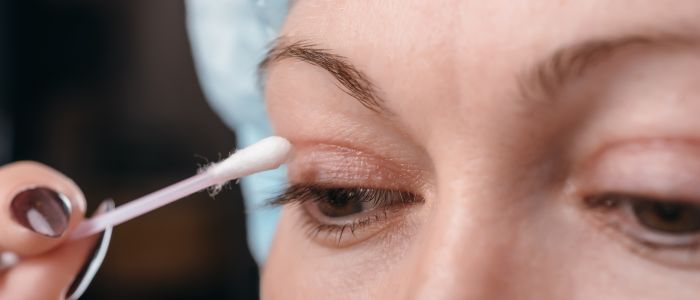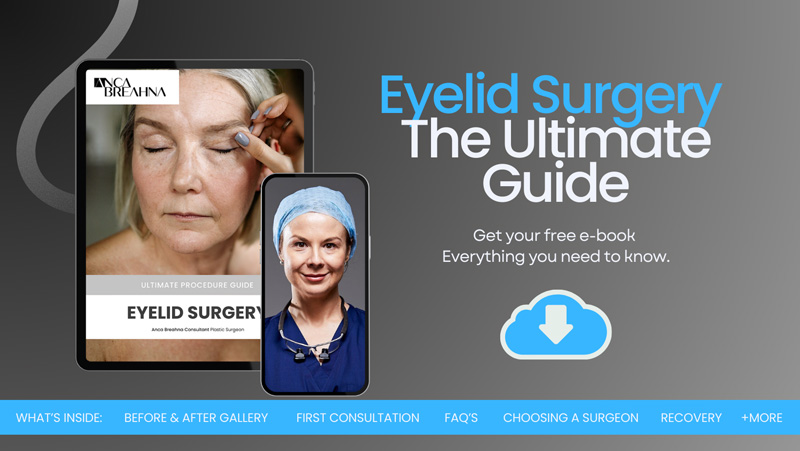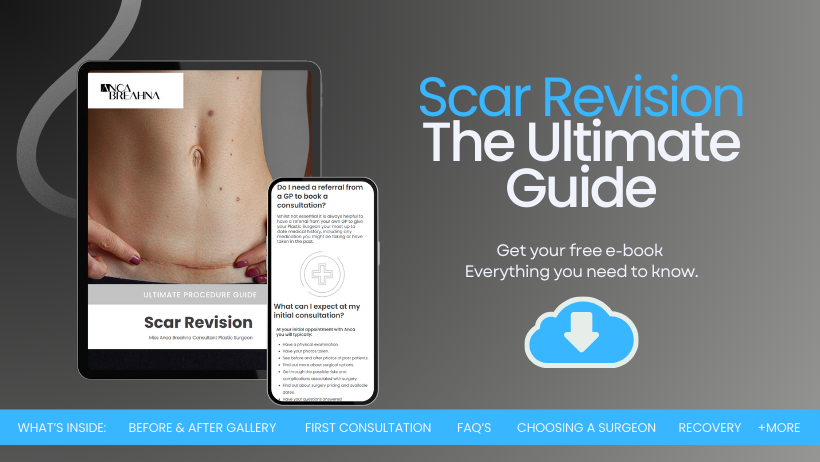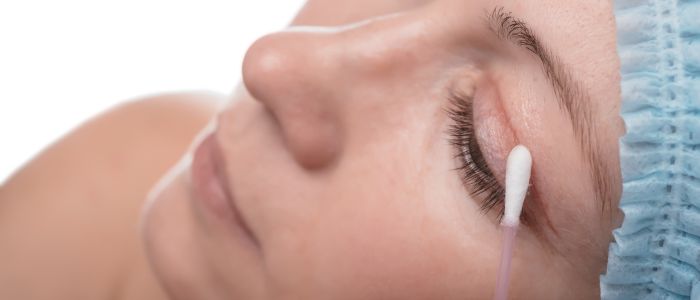
Eyelid Surgery Scars – Timeline for Healing
Blepharoplasty, commonly known as eyelid surgery, is a procedure many turn to for rejuvenating the eye area. One of the primary concerns surrounding this surgery is the appearance of scars post-operation. Understanding what blepharoplasty scars look like can help you prepare and set realistic expectations for the healing process. In this blog, Consultant Plastic Surgeon Anca Breahna will explore the anatomy of the eyelids, incision locations, types of abnormal scars, factors influencing scar appearance, immediate post-operative scar appearance, the timeline for scar healing, and scar management techniques.
Download Anca’s Guide to Eyelid Surgery

The Anatomy of the Eyelids
A thorough understanding of eyelid anatomy is essential. For patients, understanding this anatomy helps in appreciating why scars form where they do and how they might appear during the healing process.
Upper Eyelid Structure
The upper eyelid plays an important role in protecting the eye and ensuring proper vision. It consists of several layers, including skin, muscle, and connective tissue. The upper eyelid skin is the thinnest in the body, which can impact how scars form and heal. Beneath the skin lies the orbicularis oculi muscle, which controls eyelid movement. The tarsal plate provides structural support and stability to the eyelid.
Lower Eyelid Structure
The lower eyelid is similar in structure to the upper eyelid but has some differences. It also has thin skin, muscle, and connective tissue layers. However, the lower eyelid lacks the same robust tarsal plate as the upper eyelid, making it more prone to sagging and wrinkles. The lower eyelid is also involved in tear drainage, which can be affected by surgery.
Incision Locations for Blepharoplasty
- Upper Eyelid Incisions: In upper eyelid blepharoplasty, incisions are typically made in the natural creases of the eyelid. This strategic placement helps to conceal scars within the natural folds of the skin. The incision allows Anca to remove excess skin, muscle, and sometimes fat. Post-surgery, these scars are usually well-hidden when the eyes are open.
- Lower Eyelid Incisions: For the lower eyelid, incisions can be made just below the lash line or inside the lower eyelid, known as a transconjunctival incision. An incision just below the lash line is more common when removing excess skin. This approach leaves a scar along the lower lash line, which can be well-concealed with time.
- Transconjunctival Approach: The transconjunctival approach involves making an incision inside the lower eyelid. This technique is particularly useful for patients who need fat removal or repositioning without removing excess skin. Because the incision is inside the eyelid, it leaves no visible external scar, making it an attractive option for many.
Download Miss Anca Breahna’s Scar Revision Guide

Types of Abnormal Blepharoplasty Scars
- Raised Scars: Raised scars, or hypertrophic scars, occur when the body produces excess collagen during the healing process. These scars can appear lumpy or ridged and may be more noticeable than flat scars. While they can improve over time, they might require treatment to reduce their prominence.
- Hyperpigmented Scars: Hyperpigmented scars are darker than the surrounding skin. They can be a result of excessive melanin production during healing, which is more common in individuals with darker skin tones. These scars can fade over time but may need topical treatments to lighten them.
- Hypertrophic Scars: Hypertrophic scars are a type of raised scar that remains within the boundaries of the original incision. They are different from keloids, which can extend beyond the incision area. Hypertrophic scars are usually red or purple initially and can become flatter and paler over time with proper care.
- Keloid scars: Keloids are a more severe form of raised scar that extends beyond the original incision. They are often larger, thicker, and can be itchy or painful. Keloids are less common on the eyelids but can occur in individuals with a genetic predisposition. They may require more aggressive treatments, such as steroid injections or surgical removal.
Factors Influencing Scar Appearance
- Skin Type: Your skin type plays a significant role in how scars form and heal. Individuals with darker skin are more prone to hyperpigmentation and keloid formation, while those with lighter skin may experience more noticeable redness initially.
- Age: Age can affect scar formation and healing. Younger skin tends to heal more quickly but may also produce more collagen, leading to raised scars. Older skin heals more slowly and may be more prone to fine lines and wrinkles, which can influence scar appearance.
- Genetic: Genetics can greatly influence your scarring tendencies. If you have a family history of keloids or hypertrophic scars, you might be more susceptible to these types of scars. Understanding your genetic predisposition can help you and Anca plan better for scar management.
- Surgical Technique: The skill and technique are essential in determining the appearance of your scars. Anca will use precise, minimally invasive techniques to minimise tissue trauma and reduce the likelihood of prominent scarring.
- Post-operative Care: How you care for your incisions post-surgery significantly impacts scar formation. Following Anca’s instructions on cleaning, moisturising, and protecting the incision sites can promote better healing and reduce scar visibility.
Immediate Post-operative Scar Appearance
- Redness and Swelling: Immediately after blepharoplasty, you can expect redness and swelling around the incision sites. This is a normal part of the healing process as your body responds to the surgery. The redness may be more pronounced if you have fair skin, while swelling can vary depending on individual healing responses.
- Bruising: Bruising is also common after eyelid surgery. The delicate skin around the eyes is prone to bruising, which can cause the area to appear dark and discoloured. Bruising typically peaks a few days after surgery and gradually fades over the following weeks.
- Stitches or Sutures: Depending on the type of blepharoplasty, you may have stitches or sutures that need to be removed after a few days. These sutures can cause temporary scarring and redness, but they are a necessary part of ensuring the incisions heal properly.
Timeline for Scars Healing after Blepharoplasty
The healing timeline for blepharoplasty scars can vary, but there are general stages you can expect.
First Few Weeks
In the first few weeks, you will likely experience significant swelling, redness, and bruising. The incisions may look very prominent, but this is normal. Keeping your head elevated and applying cold compresses can help reduce swelling.
One to Three Months
Between one to three months post-surgery, swelling and bruising will subside considerably. The scars may still appear red or pink, but they will start to flatten and become less noticeable. Regular follow-up with Anca is essential during this period to monitor healing progress.
Three to Six Months
At three to six months, the scars should continue to fade and blend more with the surrounding skin. The redness will diminish, and the texture of the scars will improve. At this stage, any persistent issues with scar appearance can be addressed with specific treatments.
One Year and Beyond
After one year, blepharoplasty scars are typically fully matured. They should be flat, faint, and blend well with the natural skin creases. Most patients find that their scars are barely noticeable at this point.
Scar Management Techniques
Managing scars effectively after blepharoplasty is essential for achieving the best possible aesthetic outcome. Several techniques and treatments are available to minimise the appearance of scars and promote healing. Below, we explore these methods in detail:
Silicone Scar Treatments
Silicone scar treatments are widely regarded as one of the most effective non-invasive methods for improving the appearance of scars. These treatments are available in the form of gels, sheets, and creams. Silicone works by creating a protective barrier over the scar, which helps to hydrate the tissue and regulate collagen production. Consistent hydration is crucial as it prevents the scar from becoming dry and raised.
- How to Use: For gels and creams, apply a thin layer to the scar once or twice a day, as directed by Anca. Silicone sheets are typically worn for 12 to 24 hours a day and can be reused for several weeks. It’s essential to clean the skin and the sheet daily to maintain hygiene and effectiveness.
- Benefits: Silicone treatments can significantly flatten and soften scars, making them less noticeable. They are particularly useful for treating hypertrophic and keloid scars. Additionally, these treatments are non-invasive, easy to use, and generally well-tolerated with minimal side effects.
Scar Massage
Scar massage is another beneficial technique for managing scars after blepharoplasty. Massaging the scar tissue helps to break down the excess collagen that forms during the healing process. This can lead to a flatter, smoother scar. Moreover, massage improves blood circulation to the area, promoting faster and more efficient healing.
- How to Perform: Once the incision is fully healed and Anca gives the go-ahead, you can start massaging the scar. Use the tips of your fingers to gently press and move in circular motions over the scar tissue. Perform this massage for about 5 to 10 minutes, two to three times a day. Ensure that you use a gentle touch to avoid irritating the area.
- Benefits: Regular scar massage can significantly reduce the thickness and stiffness of scars. It can also help in preventing the formation of adhesions and scar bands, which can restrict movement and cause discomfort.
Laser Treatments
Laser treatments have become a popular and effective option for reducing the appearance of scars. Various types of lasers can be used depending on the scar’s characteristics, such as its colour, texture, and thickness. Common laser treatments for scars include fractional laser therapy, pulsed dye laser, and CO2 laser.
- How It Works: Laser treatments work by delivering focused light energy into the scar tissue. This energy can break down the excess pigment in hyperpigmented scars, stimulate collagen remodelling in hypertrophic scars, and improve the overall texture of the skin. Treatments are usually performed in a series of sessions, spaced several weeks apart.
- Benefits: Laser treatments can produce dramatic improvements in the appearance of scars. They can reduce redness, flatten raised scars, and improve skin texture. Although laser treatments are more invasive than topical treatments, they offer significant benefits for stubborn or severe scars.
Steroid Injections
Steroid injections are particularly effective for treating raised, hypertrophic, or keloid scars. The steroids work by reducing inflammation and suppressing the excessive collagen production that leads to raised scars. This treatment can help flatten and soften the scar over time.
- How It Works: Anca injects a corticosteroid directly into the scar tissue. The injections are typically administered every few weeks, depending on the scar’s response to the treatment. Multiple sessions may be required to achieve the desired result.
- Benefits: Steroid injections can significantly reduce the size and thickness of raised scars. They can also alleviate any discomfort, itching, or pain associated with hypertrophic or keloid scars. While this treatment can be very effective, it must be administered by a skilled professional to avoid potential side effects such as skin thinning or discoloration.
Scar Revision Surgery
For scars that are particularly prominent or troublesome, scar revision surgery might be considered. This surgical procedure involves removing the old scar and creating a new, less noticeable one. The goal is to improve the scar’s appearance and make it blend more seamlessly with the surrounding skin.
- How It Works: Scar revision surgery is typically performed under local anaesthesia. Anca excises the scar tissue and carefully sutures the wound to minimise tension and promote better healing. In some cases, additional techniques such as skin grafting or flap surgery may be used to achieve optimal results.
- Benefits: Scar revision surgery can provide significant improvements in the appearance of scars that have not responded well to other treatments. It can also address issues such as scar contracture, where the scar tissue tightens and restricts movement. This surgical option is usually considered a last resort when other methods have been ineffective.
FAQs about Blepharoplasty Scars
Can I wear makeup to cover my blepharoplasty scars during the healing process?
- Yes, you can wear makeup to cover your blepharoplasty scars, but it’s important to wait until Anca gives you the green light, usually after the stitches have been removed and the incisions have sufficiently healed. Typically, this is around two weeks post-surgery. Use hypoallergenic makeup products to avoid irritating the sensitive skin around your eyes. Gently apply and remove makeup to prevent disturbing the healing tissues.
How long should I avoid sun exposure to prevent worsening of my blepharoplasty scars?
- It’s advisable to avoid direct sun exposure for at least six months after your blepharoplasty. UV rays can cause scars to darken and become more noticeable. When going outside, wear sunglasses and a wide-brimmed hat to protect your eyes. Applying a broad-spectrum sunscreen with an SPF of 30 or higher is also essential. Anca may recommend specific sun protection practices based on your individual healing progress.
Are there any specific diets or supplements that can help improve scar healing after blepharoplasty?
- A balanced diet rich in vitamins and minerals can support the healing process. Focus on foods high in Vitamin C, which promotes collagen production, and Vitamin E, which has antioxidant properties. Zinc is another crucial nutrient for wound healing. Supplements such as arnica and bromelain can help reduce swelling and bruising. However, always consult with Anca before taking any new supplements, as some may interfere with the healing process or medications.
How can I tell if my blepharoplasty scar is healing properly or if there is an issue?
- Normal signs of healing include redness, slight swelling, and some tenderness around the incision site. These symptoms should gradually improve over the weeks following surgery. However, if you notice excessive redness, increased pain, significant swelling, pus or discharge, or if the incision starts to open, it could indicate an infection or other complication. Contact Anca immediately if you experience any of these warning signs.
Will my blepharoplasty scars look different if I have another cosmetic procedure around my eyes in the future?
- Future cosmetic procedures around your eyes can affect the appearance of your blepharoplasty scars. Scar tissue may respond differently to additional surgeries, potentially altering its texture and visibility. It’s important to discuss your full medical history and future cosmetic plans with Anca. She can consider these factors when planning the procedure to minimise any impact on existing scars and ensure the best possible aesthetic outcome.
Further Reading about Blepharoplasty with Consultant Plastic Surgeon Anca Breahna
- Read more about Blepharoplasty and Contact Lenses
- Read more about How to Reduce Swelling and Bruising after Blepharoplasty Surgery
- Read more about Upper Blepharoplasty Recovery Day by Day
- Read more about Non-Surgical Alternatives to Blepharoplasty: Do They Really Work?
- Read more about Recovery after Eyelid Surgery
- Read more about Blepharoplasty for Seniors
- Read more about When to Exercise after Blepharoplasty
- Read more about Preventing Complications in Blepharoplasty
Medical References for Blepharoplasty Surgery
- Blepharoplasty (Eyelid Surgery) – Cleveland Clinic
- Blepharoplasty: Anatomy, Planning, Techniques, and Safety – Oxford Academic
- Upper Eyelid Blepharoplasty: Evaluation, Treatment, and Complication Minimization – PubMed
- Eye Bag Surgery: Procedure, Alternatives, Cost, Recovery – Medical News Today
- Eye Lift: Blepharoplasty (Eyelid Surgery) Information – WebMD


 Ms Anca Breahna, PhD, MSc, FEBOPRAS, FRCS (Plast) is a highly regarded Consultant Plastic Surgeon specialising in the field of Aesthetic and Reconstructive Plastic Surgery. Anca performs a range of
Ms Anca Breahna, PhD, MSc, FEBOPRAS, FRCS (Plast) is a highly regarded Consultant Plastic Surgeon specialising in the field of Aesthetic and Reconstructive Plastic Surgery. Anca performs a range of 